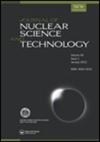14-MeV中子深穿透Cu的总截面和弹性角分布不确定度相关性的影响
IF 1.7
4区 工程技术
Q2 NUCLEAR SCIENCE & TECHNOLOGY
引用次数: 0
摘要
摘要在随机抽样方法下,采用两种不同的Total Monte Carlo方法估计了穿透厚铜基准组件后中子反应速率的不确定性。采用贝叶斯蒙特卡罗方法,通过扰动底层核模型参数,生成了500个随机核数据文件。在第一种方法中,这些文件被直接用于生成保留不同物理量之间所有相关性的处理库。第二种方法利用第一种方法产生的随机文件,但保持弹性散射角分布不变,不变为无扰动标称散射角分布。结果表明,两种方法在铜的608 mm穿透后的中子反应速率相同。然而,第一种方法的不确定度小于第二种方法。结果表明,由Wick不等式引起的0度弹性散射角分布与总截面的相关性影响了中子反应速率计算的不确定性。可以得出结论,用ENDF-6格式给出的协方差文件得到的不确定度不能给出中子侵彻计算的不确定度的正确结果。关键词:核数据的不确定性协方差横截面14mev中子总量蒙特卡罗方法不同物理量的相关性聚变中子免责声明作为对作者和研究人员的服务,我们提供此版本的已接受稿件(AM)。在最终出版版本记录(VoR)之前,将对该手稿进行编辑、排版和审查。在制作和印前,可能会发现可能影响内容的错误,所有适用于期刊的法律免责声明也与这些版本有关。竞争利益作者声明他们没有竞争利益。图1所示。截面及相关协方差的计算方案(T6,上半部分)和Total Monte Carlo (TMC)方法(下半部分)。T6中的TANES和TAFIS在本工作中未被使用。显示完整尺寸图2T6系统估算的63Cu中子总截面(灰线)与ENDF/B-VIII.0的比较(红线)和实验数据及误差[Citation15-20]。显示完整尺寸图3T6系统估算的63Cu中子弹性截面(灰线)与ENDF/B-VIII.0的比较(红线)和实验数据[Citation21-24]。显示完整尺寸图4。FNS铜基准实验计算几何模型。显示完整尺寸图5比较90Zr(n,2n)89Zr反应速率分布及T6与忽略角分布扰动结果的标准差。显示完整尺寸图659Co(n,α)56Mn反应速率分布及T6与忽略角分布扰动结果的标准差比较。显示完整尺寸图7。比较56Fe(n,p)56Mn反应速率分布及T6与忽略角分布扰动结果的标准差。显示完整尺寸图8。64Zn(n,p)64Cu反应速率分布及T6与忽略角分布扰动结果的标准差比较。显示完整尺寸图9。115In(n,n ')115mIn反应速率分布与T6与忽略角分布扰动结果的标准差比较。显示完整尺寸图10比较55Mn(n,γ)56Mn的反应速率分布和T6与忽略角分布扰动的结果之间的标准差。显示完整尺寸图11。63Cu(n,γ)64Cu的反应速率分布及T6与忽略角分布扰动结果的标准差比较。显示完整尺寸图12T6生成的1000个随机文件的63Cu总截面与0度弹性散射截面的相关性入射中子能量为14兆电子伏。显示完整尺寸图13T6生成的1000个随机文件的63Cu总截面与0度弹性散射截面的相关性入射中子能量为2.2 MeV。显示完整尺寸图14。T6生成的1000个随机文件的63Cu总截面与0度弹性散射截面的相关性入射中子能量为1.0兆电子伏。显示完整尺寸图15。T6生成的1000个随机文件的63Cu总截面与0度弹性散射截面的相关性入射中子能量为0.2兆电子伏。全尺寸显示本文章由计算机程序翻译,如有差异,请以英文原文为准。
Effects of correlations in uncertainties of total cross section and elastic angular distribution for a deep-penetration of 14-MeV neutrons in Cu
ABSTRACTUncertainty in neutron reaction rates after penetrating a thick copper benchmark assembly was estimated based on two different kinds of Total Monte Carlo methods under random sampling methodology. 500 random nuclear data files were generated for 63Cu by Bayesian Monte-Carlo method by perturbing underlying nuclear model parameters. In the first method, these files were used directly to generate processed libraries preserving all the correlations among different physical quantities. In the second method, the random files generated in the first method were used but the angular distributions of elastic scattering were kept fixed to those of the non-perturbed nominal one. It was found that the two methods gave the same neutron reaction rate after 608 mm penetration of a copper. However, the uncertainty of the first method was smaller than that of the second method. It shows that the correlation between angular distribution of elastic scattering at 0 degrees and total cross section, which stems from Wick’s inequality, affects uncertainty of the calculated neutron reaction rate. It could be concluded that the uncertainty obtained by using the covariance files given in the ENDF-6 format may not give correct results for the uncertainty of neutron penetration calculations.KEYWORDS: Uncertainty of nuclear datacovariancecross-sections14MeV neutron63Cutotal Monte Carlo methodcorrelation of different physical quantitiesfusion neutronicsDisclaimerAs a service to authors and researchers we are providing this version of an accepted manuscript (AM). Copyediting, typesetting, and review of the resulting proofs will be undertaken on this manuscript before final publication of the Version of Record (VoR). During production and pre-press, errors may be discovered which could affect the content, and all legal disclaimers that apply to the journal relate to these versions also. Competing interestsThe authors declare that they have no competing interests.Figure 1. Calculation scheme of cross section and associated covariance (T6, upper part), and the Total Monte Carlo (TMC) method (lower part). TANES and TAFIS in T6 were not used in the present work.Display full sizeFigure 2. 63Cu neutron total cross sections estimated by T6 system (gray lines) compared with ENDF/B-VIII.0 (red line) and experimental data and the errors [Citation15–20].Display full sizeFigure 3. 63Cu neutron elastic cross sections estimated by T6 system (gray lines) compared with ENDF/B-VIII.0 (red line) and experimental data [Citation21–24].Display full sizeFigure 4. Computational geometry model of FNS copper benchmark experiment.Display full sizeFigure 5. Comparison of 90Zr(n,2n)89Zr reaction rate distribution and the standard deviation between T6 and the result ignoring perturbation of angular distribution.Display full sizeFigure 6. Comparison of 59Co(n,α)56Mn reaction rate distribution and the standard deviation between T6 and the result ignoring perturbation of angular distribution.Display full sizeFigure 7. Comparison of 56Fe(n,p)56Mn reaction rate distribution and the standard deviation between T6 and the result ignoring perturbation of angular distribution.Display full sizeFigure 8. Comparison of 64Zn(n,p)64Cu reaction rate distribution and the standard deviation between T6 and the result ignoring perturbation of angular distribution.Display full sizeFigure 9. Comparison of 115In(n,n’)115mIn reaction rate distribution and the standard deviation between T6 and the result ignoring perturbation of angular distribution.Display full sizeFigure 10. Comparison of 55Mn(n,γ)56Mn reaction rate distribution and the standard deviation between T6 and the result ignoring perturbation of angular distribution.Display full sizeFigure 11. Comparison of 63Cu(n,γ)64Cu reaction rate distribution and the standard deviation between T6 and the result ignoring perturbation of angular distribution.Display full sizeFigure 12. Correlation between 63Cu total cross section and elastic scattering cross section at 0 degrees of 1,000 random files generated by T6. Incident neutron energy is 14 MeV.Display full sizeFigure 13. Correlation between 63Cu total cross section and elastic scattering cross section at 0 degrees of 1,000 random files generated by T6. Incident neutron energy is 2.2 MeV.Display full sizeFigure 14. Correlation between 63Cu total cross section and elastic scattering cross section at 0 degrees of 1,000 random files generated by T6. Incident neutron energy is 1.0 MeV.Display full sizeFigure 15. Correlation between 63Cu total cross section and elastic scattering cross section at 0 degrees of 1,000 random files generated by T6. Incident neutron energy is 0.2 MeV.Display full size
求助全文
通过发布文献求助,成功后即可免费获取论文全文。
去求助
来源期刊

Journal of Nuclear Science and Technology
工程技术-核科学技术
CiteScore
2.40
自引率
16.70%
发文量
116
审稿时长
2.3 months
期刊介绍:
The Journal of Nuclear Science and Technology (JNST) publishes internationally peer-reviewed papers that contribute to the exchange of research, ideas and developments in the field of nuclear science and technology, to contribute peaceful and sustainable development of the World.
JNST ’s broad scope covers a wide range of topics within its subject category, including but are not limited to:
General Issues related to Nuclear Power Utilization: Philosophy and Ethics, Justice and Policy, International Relation, Economical and Sociological Aspects, Environmental Aspects, Education, Documentation and Database, Nuclear Non-Proliferation, Safeguard
Radiation, Accelerator and Beam Technologies: Nuclear Physics, Nuclear Reaction for Engineering, Nuclear Data Measurement and Evaluation, Integral Verification/Validation and Benchmark on Nuclear Data, Radiation Behaviors and Shielding, Radiation Physics, Radiation Detection and Measurement, Accelerator and Beam Technology, Synchrotron Radiation, Medical Reactor and Accelerator, Neutron Source, Neutron Technology
Nuclear Reactor Physics: Reactor Physics Experiments, Reactor Neutronics Design and Evaluation, Reactor Analysis, Neutron Transport Calculation, Reactor Dynamics Experiment, Nuclear Criticality Safety, Fuel Burnup and Nuclear Transmutation,
Reactor Instrumentation and Control, Human-Machine System: Reactor Instrumentation and Control System, Human Factor, Control Room and Operator Interface Design, Remote Control, Robotics, Image Processing
Thermal Hydraulics: Thermal Hydraulic Experiment and Analysis, Thermal Hydraulic Design, Thermal Hydraulics of Single/Two/Multi Phase Flow, Interactive Phenomena with Fluid, Measurement Technology...etc.
 求助内容:
求助内容: 应助结果提醒方式:
应助结果提醒方式:


